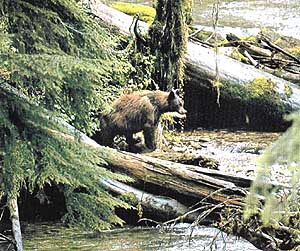by Chalerm Raksanti
Alaskans as a rule pride themselves on their
willingness to buck the elements. That might be well and good for those
who dwell in the frozen frontier of the northern part of America’s 49th
state. But there is another Alaska. There is that nearly 600 mile-long
handle on a 550, 850 square mile pan, which is largely removed from the
bulk of the state by the St Elias Mountains, one of the highest coastal
ranges in the world. On the other side is an ice field the size of Rhode
Island. The mentality and the state of mind of those who dwell here are
separated from the rest of the state as well.
 A
brown bear forages in Misty Fjords National Monument area.
A
brown bear forages in Misty Fjords National Monument area.
In truth it is cold, wet and lonely in the Southeast in
winter. A squall can come in from the sea and can slam an unwary plane or
boat without warning. And it rains, and rains and rains. But the tourists
have left and the place is peaceful. Fishermen stay home and visit with
their neighbors. Everyone snuggles up together like one big happy family.
With some 1,000 islands off shore, and a measly number of roads open year
round, they don’t really have much choice.
But when summer comes, the sun starved Southeasterners
live just like everyone else in what they call the “lower 48” (the
rest of the USA’s mainland 48 states). And in their opinion, they live
in paradise. The Kurishio, a warm current that moves though the Pacific
Ocean, renders the southeast coastal climate temperate. On a welcome clear
day, ferries dot the many inlets and bays carrying passengers back and
forth to the various islands. The ferries have an almost festival
atmosphere on board. Locals, young back-packers, newlyweds and elderly
tourists all climb aboard and make a party of the passage.
 An
American bald eagle with a radio transmitter fastened to his back
An
American bald eagle with a radio transmitter fastened to his back
Of course Alaska is bear country. And the southeast is
no exception. Admiralty Island is a lush habitat for brown bears with its
forest canopy and grassy flats. Bears squat on alpine meadows, watching
the visitors watch them. Park rangers figure there is a brown bear here
for every square mile, making it one of the most populated bear habitats
in the world.
The largest known congregation of bald eagles lines the
banks of the Chilikat River each year from October to January. Like
ornaments on Christmas trees, eagles by the thousands decorate cottonwood
trees before flying off to feast on dying salmon that populate the river.
There is also an eloquent record of tribal history of
the indigenous peoples of Alaska’s ethnic Indian and Inuit population.
Spirit men and shamans still hold places of prestige here. Fishing boats
line the docks of Ketchikan, Alaska’s 5th largest city. Catches of pink
salmon peaked in the 1940s but after statehood was achieved, management
techniques improved and fish traps were outlawed.
 An
Alaskan “spirit man” man. Shamans play an intricate role in tradition
ceremonial rites
An
Alaskan “spirit man” man. Shamans play an intricate role in tradition
ceremonial rites
At Skagway, during the height of the fevered in 1869
“Gold Rush”, the town boasted a population of 15,000. Few stayed,
however. But the city stabilized, after a fashion, on the strength of less
glamorous lead and zinc. Even now, the town ekes out a living from
tourists. It’s a tough little town. The community was born of rock. Its
forefathers endured some of the most grueling trials men can suffer as
they headed for the Klondike, over Chilkoot Pass. There is still plenty of
evidence left even today to mark the hardships the men with ‘gold
fever’ bore along the Chilkoot route. It is a trail referred to as the
“meanest 32 miles in history.”
The pace of life in the countryside is quiet and slow.
Alaskans are used to isolation. Relaxation and pastimes are as divergent
as the people who populate the coastal area. Playing cards and cribbage,
they cozy up around a neighborhood tavern and while away the winter, or
soak in some of the hot springs along the coast. They have learned that if
the mail is slow, wait patiently until the mail plane arrives. If they get
hungry for fresh produce, they telephone and order it from the nearest
city. It also arrives by plane. Often homes and farms are set far apart
from others. A lifeline to the region’s scattered settlements, float
planes provide a myriad of services. Never mind. Spring and summer here
are splendid and the winter brings a tranquility the residents have
learned to treasure.